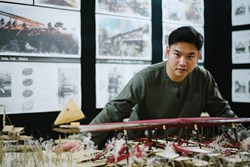Elim Hu from Waipapa Taumata Rau, The University of Auckland, Te Pare School of Architecture and Planning is a finalist for her project 'The Care We Sow The Children They Know'.
Project description
The Care We Sow, The Children They Know is a project that places the equity of care at the heart of architecture within New Zealand’s special education schools, where infrastructural inequity persists. The central question explores how architecture can bridge the gap between special education and mainstream schools, transforming our built environments into active places of care where care is not found. How can the school stretch its wings beyond its walls into the community, unboxing the hidden worlds that lie within. To become more than a school.
The site for the project is Sommerville Special School in Panmure, Auckland, New Zealand’s largest special needs school. Volunteering there provided a deeply moving, firsthand understanding of the lives of special needs children. Drawing on John Hejduk’s concept of masques, the proposal begins at the smallest scale with 12 playful characters. Conceived from the various special needs toys sighted from Sommerville school, they become evolving tactile objects of meaning for the schools rebuild. These 12 masques transform from drawing to model to school wide scale. Each masque represents a theme of protection, care, curiosity and so on to mend the neglected fabric of Sommerville school. Sommerville school’s emblem, the Kuaka, becomes the final masque organising the spaces on masterplan. The Māori legend asks, “Where is the nest of the Kuaka?” The nest becomes a metaphor for the school itself: a place held by the wing-like forms that guide and shelter its children.
The design proposes re-crafting the aging campus through care and the Atypical. Sommerville school transfigures incrementally into an ensemble of architectural masques that respond directly to the children’s needs. Each building works together to form a dialogue of care, inclusivity and community spirit connecting Sommerville School to its neighbour, Tamaki Primary School. The school is rebuilt through upcycling demolished materials and re-crafting spaces attuned to children’s sensory and tactile needs.
The project positions architecture as an instrument of empathy. When our built environments are designed explicitly to care, they not only support the people within, but broader cultures of awareness, conversations and responsibility are activated for our communities.






